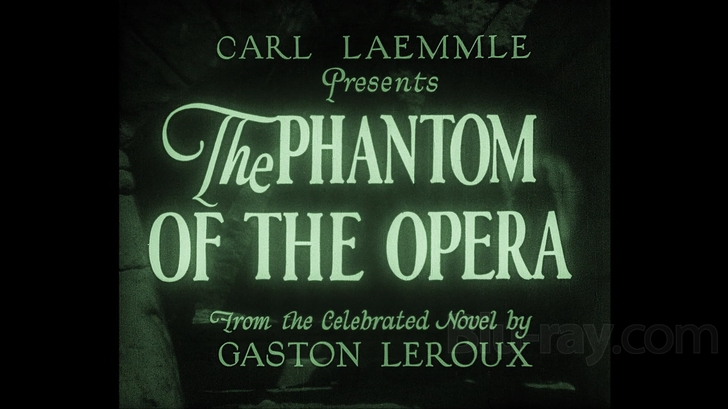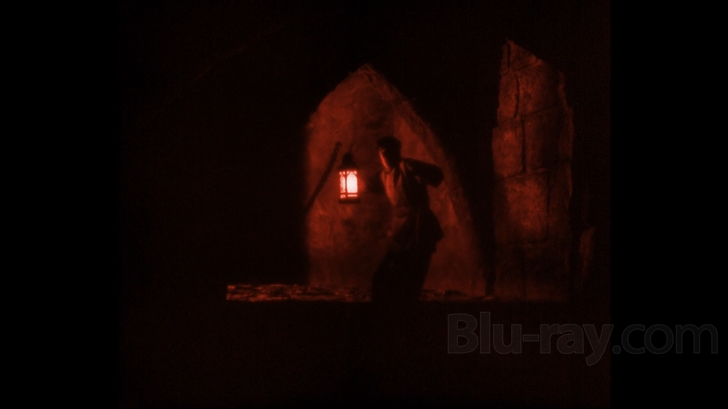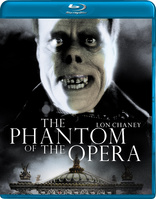The Phantom of the Opera Blu-ray Movie
HomeThe Phantom of the Opera Blu-ray Movie 
1925 version plus two 1929 reissue restored versionsImage Entertainment | 1925 | 1 Movie, 3 Cuts | 93 min | Not rated | Nov 01, 2011
Movie rating
8 | / 10 |
Blu-ray rating
| Users | 4.5 | |
| Reviewer | 4.0 | |
| Overall | 4.0 |
Overview
The Phantom of the Opera (1925)
At the Opera of Paris, a mysterious phantom threatens a famous lyric singer, Carlotta and thus forces her to give up her role (Marguerite in Faust) for unknown Christine Daae. Christine meets this phantom (a masked man) in the catacombs, where he lives. What's his goal ? What's his secret ?
Starring: Lon Chaney, Mary Philbin, Norman Kerry, Arthur Edmund Carewe, Gibson GowlandDirector: Rupert Julian
| Horror | Uncertain |
| Drama | Uncertain |
| Romance | Uncertain |
Specifications
Video
Video codec: MPEG-4 AVC
Video resolution: 1080p
Aspect ratio: 1.2:1
Original aspect ratio: 1.33:1
Audio
English: LPCM 2.0
Subtitles
None
Discs
50GB Blu-ray Disc
Single disc (1 BD)
Playback
Region A (locked)
Review
Rating summary
| Movie | 4.0 | |
| Video | 3.5 | |
| Audio | 4.0 | |
| Extras | 3.5 | |
| Overall | 4.0 |
The Phantom of the Opera Blu-ray Movie Review
Scary, but a little creaky, too.
Reviewed by Jeffrey Kauffman October 27, 2011Note: There are some technical issues with the first pressing of this disc which are still being addressed by
Image. I am in touch with several sources and will update this review if/as information becomes available.
Note 2: Scores above are averages spread over the three cuts of the film. See below for detailed information on
each cut.
Years ago I was conducting a production of the musical Godspell and had a full day of auditions scheduled. In
what turned out to be something of a major headscratcher, one which had me convinced I was being filmed for an
episode of Candid Camera or Punk’d, I had 25 sopranos audition that day and each and every one of
them brought in “Memory” from Cats as their audition piece. Now I chalked up the first three or four to mere
coincidence—after all, Cats had at that point just opened on Broadway, was a huge smash and Barbra
Streisand’s pop version of the tune was topping the charts. But by the time I was approaching the twentieth of the
young women auditioning and was still being greeted with the sheet music of "Memory", I sensed a more sinister
influence at work, namely the ungodly allure of Andrew Lloyd Webber for young female singers. It’s somewhat ironic
then that Webber should have gone on to even greater acclaim for his musicalization of Phantom of the Opera,
a show which is after all about the ungodly allure of a master musician on a young female singer, and a show which
seems to appeal somewhat preternaturally to women (including, heaven help me, my wife) more than men. I had loved
Andrew Lloyd Webber’s work in Jesus Christ Superstar, but found a lot of his subsequent material less than
appealing, an unsettling combination of pastiche and quasi-Puccini, especially with regard to his
Phantom, that never set very well with me. (Musical lovers know there’s another musical Phantom, one
by Nine’s Maury Yeston, that many aficionados, including me, prefer). Be that as it may, the planetary sensation
caused by Webber’s Phantom of the Opera quickly eclipsed older versions, and many lovers of the musical are
only faintly aware that there were equally iconic versions, many of which were, in their day at least, as sensational as
Webber’s was in the eighties and nineties. Chief among these is the legendary Lon Chaney silent film version, originally
released in 1925 and then rejiggered in late 1929-early 1930 at the dawn of the sound era with interpolated segments
which featured a synchronized soundtrack. (It should be noted that it's to Lloyd Webber's credit that he has always
cited the Chaney Phantom as one of the prime influences on his musical). This new Blu-ray release offers three
versions of the film, two high
definition remasters of the 1929 version, one at 24fps sourced from a 35mm negative, and another 1929 version
running at 20fps. A
standard definition version of the original 1925 film is also offered, sourced
from a 16mm print (somewhat humorously misdescribed on the back cover as a 6 millimeter print, which some
viewers may actually believe when they see the condition of this version).

The Phantom of the Opera is one of those properties that seems to have entered the collective unconscious, and certainly buried in the deepest, darkest recesses of most film lovers’ Ids is the image of Lon Chaney in his truly horrific makeup as Erik, the tormented artist whose disfigurement leads to madness and obsession. This early Carl Laemmle production seemed to be the template for what would become Universal’s stock in trade for the next couple of decades, the elegant horror film. While many people trace Universal’s penchant for mining horror to Dracula or Frankenstein, really it’s this Phantom of the Opera, along with Chaney’s Hunchback of Notre Dame, which set the studio on the course which largely defined it during the thirties and forties. Phantom has seen a plethora of home video releases by virtually every public domain label imaginable, with varying quality. Collectors have long gravitated largely toward two releases, one of those being by David Shepard, who released two laserdisc versions in the nineties, and it is his work (some of which was ported over and/or redone for an Image DVD) which is offered on this new Image Blu-ray. (The other “big” DVD release was the Milestone Ultimate Edition, which had a plethora of excellent extras but which suffered from less than stellar video. Milestone is releasing their own BD of their version in early 2012. There’s also a very good four DVD set preserving the excellent Essex Films/Griggs- Moviedrome print of the 1929-30 version available from ReelClassicDVD).
This Phantom of the Opera shows its age, to be sure, but it has held up surprisingly well. While co-stars Mary Philbin and Norman Kerry hardly set the screen on fire (as commentator Jon Mirsalis notes), an evocative and then-gargantuan production design, as well as Chaney’s commanding performance more than make up for the lack of chemistry between the supposed romantic duo. What is so fascinating about this film is that Chaney is really not all that present and yet his presence looms over the entire film in a menacing way. For the first half hour or so, he’s only seen sparingly, and then only in shadow or silhouette, making the iconic unmasking of him in the bowels beneath the Paris Opera all the more dramatic. Director Rupert Julian (aided by an uncredited Edward Sedwick and even Chaney himself for reshoots Laemmle ordered both for the 1925 and rejiggered 1929-30 versions) keeps things moving fairly briskly, though truth be told the original 1925 version can be a somewhat slow slog at times, despite its more coherent and cohesive storyline. The special effects are really quite convincing considering the age of the film, and Chaney’s makeup certainly still retains its horrific nature and certainly is still easily one of the most disturbing transformations in the annals of film, silent or otherwise.
For audiences raised on contemporary in your face horror films, this Phantom of the Opera may seem quaint, in fact perhaps even boring. But for 1925 (and 1929-30) audiences, it was a deeply disturbing experience, one which caused headlines nationally when moviegoers actually passed out at the sight of Chaney’s hideous disfigurement for the role. While the film is no doubt creaky by today’s standards, it still manages to be an incredibly moody, evocative piece now almost a century after its release. That’s a testament to the craft of Chaney, Julian and the other artists who helped to put Phantom on the map and (heaven help us all) pave the way for all those other versions—Andrew Lloyd Webber’s included—that followed.
Note 3: Perhaps part of the technical issues alluded to above (more about which you can read in both the Video and Audio sections of this review), Image has authored this Blu-ray a bit strangely, and perhaps even confusingly, for those who are going to get to the main menu and wonder where the different versions advertised are. The three different versions must be accessed by choosing their respective scores, though even then, there are options for the Gaylord Carter organ score on the 24fps 1929 version and the audio commentary by Dr. Jon Mirsalis on the 20fps 1929 version. Most troublingly, once a choice has been made for any given version, exiting to the main menu still leaves that choice as the only option, only Scenes or, if applicable, the different audio options are available. In other words, if you want to change from any of the three versions to another version, you must either fast forward or chapter skip to the end of that particular version or the disc must be ejected and reinserted to get back to a “cold” main menu.
The Phantom of the Opera Blu-ray Movie, Video Quality 

The Phantom of the Opera is presented on Blu-ray with an AVC codec. The 24fps 1929 version is offered in
1080p in a 1.2:1 aspect
ratio. The 20fps 1929 version is presented in 1080i in a 1.2:1 aspect ratio. The 1925 version of the film is presented in
480p standard definition in an aspect ratio of 1.37:1. The press
releases accompanying
this release are a tad confusing. Both the 24fps and 20fps versions were sourced from the same 35mm negative (the first time this particular
element has ever been used for a home video release), but the restoration algorithms utilized by FotoKem only work well with standard frame
rates, so there is a noticeable quality difference between the 24fps and 20fps versions. The good news is that the
24fps 1929 version is
going to be a minor (perhaps even a major) revelation to those who have grown up with inferior 16mm transfers of this
film. The transfer is
surprisingly damage free. Don't get me wrong—there is still abundant speckling, scratching and nitrate decomposition
(especially in the
famous boudoir scene), but overall this is an incredible improvement on any version I've previously seen (and I've seen
lots, believe me). The
two strip Technicolor Bal Masque sequence looks great, if a tad soft, with the reds popping magnificently. Several other
sequences have been
hand colored to recreate the original Handschiegl Color Process. The 24fps version offers superior clarity and sharpness,
within reasonable
expectations. The 20fps 1929 version is a rather major step downward in quality, at least in terms of visible damage if not in overall clarity
and sharpness. This
version has considerably
more wear and tear, with many more scratches, flecks and specks dotting the image with fair regularity. It still has some
nicely sharp
moments and those who prefer 20fps for their silents will most likely not be too disappointed. The 1925 version, in
standard def and sourced
from a 16mm print, is obviously the worst looking of the bunch. The image is often quite fuzzy and some of the inserts,
as in the letters which
are seen in close-up, verge on the unreadable. Still, it's wonderful to be able to see the (more or less) original version of
the film, despite its
obvious drawbacks.
Note: Screencaps 1-10 are from the 24fps version. 11-15 are from the 20fps version (and have been deinterlaced
before uploading). 16-
19 are from the SD 1925 version. Do not be concerned with the AR on the 1925 screencaps. Our system stretched the
SD image, it is
correctly formatted at 1.37:1 on the disc. The SD screencaps are offered only so that you have a benchmark of basic
quality to go by).
The Phantom of the Opera Blu-ray Movie, Audio Quality 

Producer David Shepard has detailed that the original pressing of this BD incorrectly offered mono soundtracks instead of the advertised new stereo tracks. With that caveat, and with the understanding that my score above is based on the audio options and fidelity aside from the stereo issue, let's address all of the audio options on this Blu-ray, all presented (ostensibly) in uncompressed LPCM 2.0. The 24fps version has an all new orchestral score (which is perhaps anachronistically too modern at times, with lots of percussion and dissonance) by the Alloy Orchestra. Purists may want to choose the iconic Gaylord Carter organ score which is offered as an alternate audio option on this version. The 20fps 1929 version has the previously released Gabriel Thibaudeau score performed by I Musici de Montréal, conducted by Yuli Turovsky and featuring soprano Claudine Côté. The 1925 version advertises an "all new" piano score by Frederick Hodges, but it is in fact a pastiche of musical quotes from everyone from Brahms to Gounod. The fidelity on all these tracks is superb, with brilliant reproduction through all frequency ranges. Hopefully I will receive a corrected disc from Image and at that point I can address stereo separation.
The Phantom of the Opera Blu-ray Movie, Special Features and Extras 

- Commentary (Audio Essay) by Dr. Jon Mirsalis. This is presented as an alternate audio option on the 20fps 1929 version. Mirsalis provided the score for another home video release of Phantom of the Opera (which he ingenuously if affably pimps on this commentary). Mirsalis also runs an internet site devoted to Lon Chaney, and he is an eminently listenable authority on Chaney in general as well as this film in particular. He spends quite a bit of time detailing various differences between the 1925 and 1929-30 versions, and he also talks quite a bit about Chaney's "lost" films, as well as some of the technical aspects of this film, including Chaney's horrific makeup. This is a fascinating and extremely informative commentary.
- Interview with Gabriel Thibaudeau (SD; 10:25) is culled from a 2004 PBS broadcast and features the composer (whose work is on the 20fps 1929 version) talking about his love of the film and how he approached scoring it.
- Photo Gallery (HD; 13:30)
- Script (HD; 8;41). This will play continuously if you don't pause to read individual pages.
- Souvenir Program (HD; 1:34). As with the script, this continues to play unless you press pause to peruse the individual pages.
The Phantom of the Opera Blu-ray Movie, Overall Score and Recommendation 

Silent film aficionados haven't had all that much to celebrate on Blu-ray thus far, and so this release is hotly anticipated. The bad news is there are some issues on this first pressing that need to be addressed. The good news is, once those are addressed, this is going to be a stellar release, especially with regard to the amazing looking 24fps 1929 version of this film, which is easily the cleanest and clearest looking version of Phantom I've personally ever seen. Stay tuned to this review for further developments, as I will make sure to update it as more information becomes available. My bottom line is, hold off on this for the time being until we get some definitive information from Image about a repressing. But once that hurdle is overcome, this is a no-brainer for Phantom fans.
Other editions
The Phantom of the Opera: Other Editions
Similar titles
Similar titles you might also like

The Hunchback of Notre Dame
1923

Baron Blood
Gli orrori del castello di Norimberga
1972

Fright Night 2: New Blood
2013

Mad Love
Warner Archive Collection
1935

The Lodgers
2017

Son of Frankenstein
1939

The Wolf Man 4K
1941

The Eyes of My Mother
2016

Mr. Sardonicus
1961

Son of Dracula 4K
1943

Frankenstein 4K
1931

The Nightcomers
1971

The Crimson Cult
Curse of the Crimson Altar
1968

The Bride of Frankenstein 4K
1935

Hell Night
Collector's Edition
1981

Gwen
2018

Marrowbone
The Secret of Marrowbone
2017

Tales of Halloween
2015

The Disappointments Room
2015

Kiss of the Damned
2012

